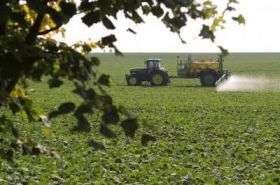New formula for combating the greenhouse gas nitrous oxide

The cost of treating wastewater contaminated with nitrogen could be lowered in future. Soil scientists at the Helmholtz Centre for Environmental Research (UFZ) have developed a new mathematical model which can help determine the optimum conditions for microbiological water treatment. Using the stable natural nitrogen isotope 15N, this mathematical model, which is the most accurate to date, can for the first time calculate exactly the quantities of dinitrogen (N2) produced by the complex biochemical treatment processes anammox and denitrification and the background levels in the atmosphere, according to the researchers writing in the specialist journal Rapid Communications in Mass Spectrometry.
This means that in future the effectiveness of such wastewater treatment plants can be significantly improved and emissions of the greenhouse gas N2O (a by-product of denitrification) can be avoided.
As well as the greenhouse gas carbon dioxide (CO2), which has been the subject of much public debate, the less well known nitrous oxide (N2O, also known as ‘laughing gas’) also plays a key role in climate change. As with CO2, a steep rise in atmospheric concentrations of nitrous oxide has been registered since the start of industrialisation.
Although the concentration of carbon dioxide in the atmosphere is about 1000 times higher than that of nitrous oxide, nitrous oxide is 300 times more powerful in terms of its greenhouse gas effect than carbon dioxide. In contrast with CO2, the increase in atmospheric N2O concentrations is due only in small part to the combustion of fossil fuels. By far the greatest proportion of the N2O released by humans results from the excessive use of nitrogenous nutrients (such as nitrate/NO3-), which are converted into the greenhouse gas N2O by natural microbial processes (nitrification and denitrification).
One of the key concerns of the European Water Framework Directive (WFD), which came into force in 2000, is the reduction of nitrogen-containing nutrients in waterbodies. One approach is to avoid or optimise the use of nitrogen fertilizers in agriculture. Another approach is to improve wastewater treatment technologies.
The idea for developing the new mathematical approach using the stable nitrogen isotope 15N came from their collaboration with UFZ colleagues Peter Kuschk and Diego Paredes, who have been looking at the possibility of microbial treatment of nitrogenous wastewater using anammox for a long time. But the new equations are also of great significance for their own work. In 1992 Japanese scientists described for the first time a metabolic process involving soil fungi (Fusarium oxysporum) which is very similar to the process of anaerobic oxidation of ammonium and which was called codenitrification, after the familiar process of denitrification.
Despite this, even 15 years after the discovery of codenitrification, scientists still work on the assumption that when nitrogen from the soil is broken down, it is only denitrification that is responsible for the release of molecular nitrogen (N2). Using the 15N isotope technique and the new mathematical approach, it is now possible to calculate precisely the N2 released from the soil during both processes – denitrification and codenitrification. An initial, very recent study by two British scientists has already come to the surprising conclusion that up to 92 per cent of microbially released N2 is attributable to the process of codenitrification.
If these initial results can be confirmed and extended to other soils around the world, this would completely change our current understanding of N2 emissions from the soil. The two scientists Oliver Spott and Florian Stange will be using the new equations to tackle this question in collaboration with international scientists.
Source: Helmholtz Association of German Research Centres

















